Since I was a kid, every family gathering I can remember eventually turned into playing games at the table with relatives young and old. I was lucky enough to learn tons of games passed down from the older generation that didn’t come from a cardboard box at the store. Since then I’ve seen a lot of these games actually turned into retail versions which feels a bit devious to me, like trying to copyright and box tic tac toe (which I’ve seen done). I’d like to share some of my favorite games you can play just with cards, dice, and other stuff laying around. Whether you’re trying to save funds, save space, or just discover an old classic, these games should help you out.
Spoons
Supplies: A deck of cards and a bunch of spoons
Similar to: Jungle Speed, Slap 45, Pit
Spoons is a dead simple game of reflexes and panic. Using a deck of playing cards, each player takes a card passed to them from the right, and then passes one card to the player on their left, trying to collect a four of a kind in their hand. The first player to do so gets to take one of the spoons on the table. But the next rules turn this from kiddy card game to adrenaline-soaked bloodsport. First, there are no turns. You can pick up and pass cards as fast as you get them, and no matter how fast you go you always suspect someone else is closer to victory. Secondly, once someone has already grabbed a spoon, then any player can grab a spoon. And finally, there are one fewer spoons than there are players. This creates a game that shifts suddenly from manic card grabbing to musical chairs at the drop of the hat. Whoever is stuck without a spoon is eliminated, and you continue the next round with one less player and one less spoon, until there is one victor.
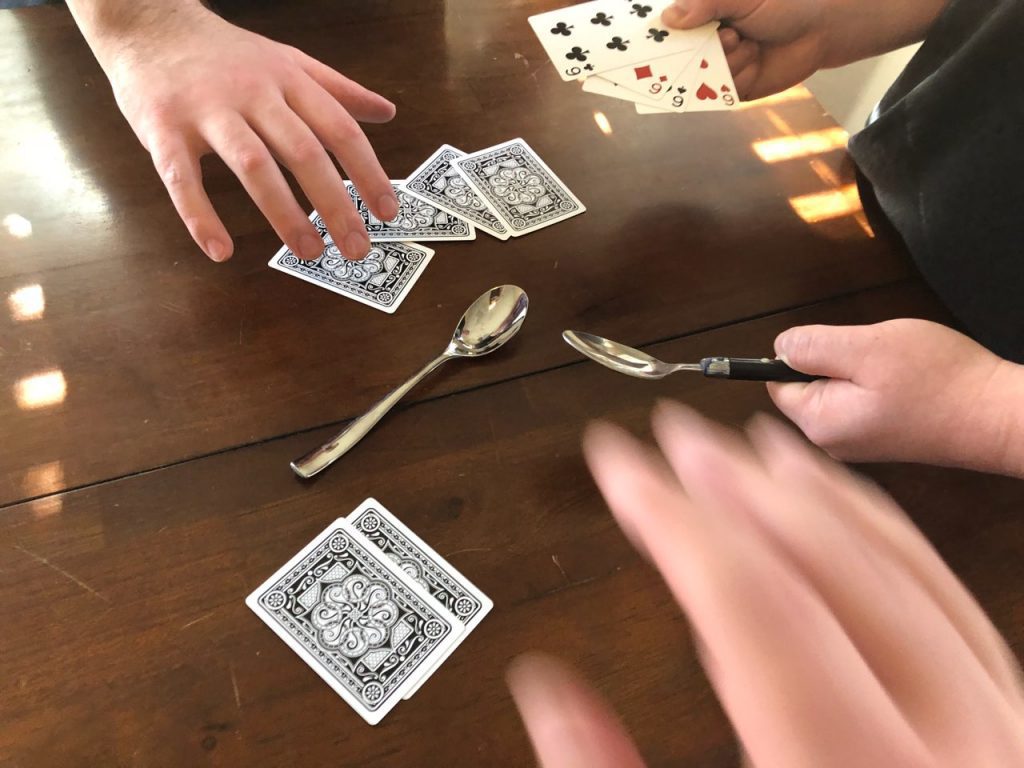
The anxiety felt when anyone jostles a spoon, the joy from getting four of a kind and then silently picking up a spoon without being detected, the chaotic physics of spoons launched into the air by panicked fingers. These are the reasons why I love this game. Spoons is the game that inspired this article. Despite only requiring a deck of cards and some spoons to play, I’ve spotted retail boxes of this game for sale. Skip the game store and deal this one at home. For an even more physical game, put the spoons in another room!
Farkle
Supplies: Six dice, pen and paper
Similar to: Can’t Stop, Pass the Pigs, Zombie Dice
Dice were my first gaming love, and there’s a classic dice game I learned in college that captures the highs and lows of risking one more roll. In Farkle you take turns rolling six dice, hoping to get certain scoring combinations like three of a kind or single ones. If your roll has points, you can stop and score them.
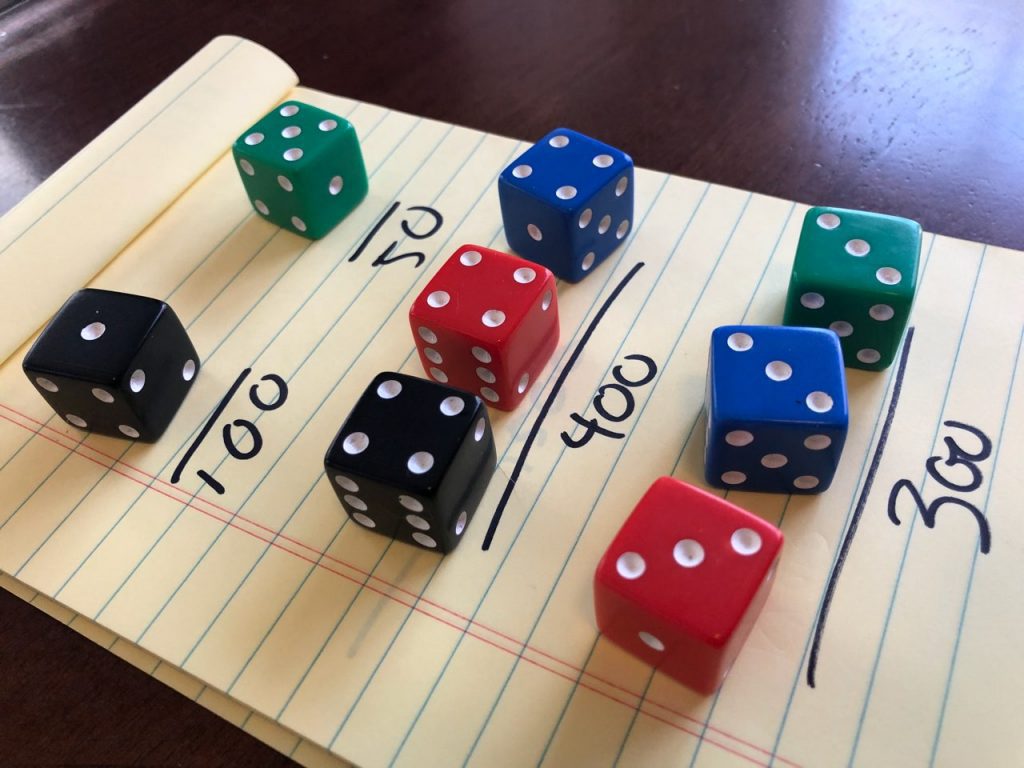
But, you could also pick up your leftover non-scoring dice and try to earn points with them as well. As long as the dice you roll earn you more points, you can keep rolling extra dice, and if you get all six dice scoring points you get hot dice and can reroll all six. But, if your roll ever fails to score points, that’s a Farkle and your turn is over. All those points you got this turn? Gone.
This push your luck formula will be familiar to anyone who knows Pass the Pigs or Zombie Dice. What makes Farkle fun is how much the score can swing by literally thousands of points on your best turns. Like many traditional games there’s also decades worth of rules variants. Some are just scoring tweaks, others wipe your entire score if you get too many Farkles in a row, or you can have a minimum score you need per roll before you can safely end your turn. If you have a copy of Monopoly, Catan, and Backgammon, you have all you need to play Farkle.
Spades
Supplies: A deck of cards, pen and paper
Similar to: Fox in the Forest, Nyet, Diamante
Trick taking games have had a small resurgence in games like Fox and the Forest, and Trickster, adding unique powers and abilities to entice players accustomed to the variety found in modern board games. But this genre dates back generations, and one of my favorite variations on the theme is the game of Spades.
In this trick taking card game, four players in teams of two are dealt a deck of cards and then, based solely on their hand and the bids of others, must state how many tricks they hope to win that round. This bidding ensures that the winner is not necessarily the player with the highest ranked cards, but the one who can best assess their hand and can skillfully use it to make their bid and avoid extra tricks.

This is reinforced by the scoring where a completed contract, the combined bid of one team, is worth ten times the bid that the players made, plus one point for each trick scored beyond the bid. So an accurate bid of 5 is worth 50 while winning the same 5 tricks after a bid of 6 is worth nothing. However, bidding conservatively also has it consequences as for every ten total overtricks, or “bags”, a team scores, they then lose 100 points!
This threat of bagging out and losing points creates dynamic pressure on the bidding phase. If you’re at say 60 points even with no overtricks, you can afford to bid low, but if you’re at the cusp of a penalty with 459 points, within striking distance of the 500 point victory line, suddenly you can’t afford to gain even a single extra trick. Since every round has 13 tricks, once the bids are in you can immediately tell if the total is too high, leading to a fight to take tricks, or too low, creating a bizarre competition to force wins upon your opponent to burden them with bags.
Trick taking card games were always the conclusion to a night spent sharing a meal with my extended family. The easy pace in these games lets hours pass easily into the night while folks are free to catch up with friends and family. There’s enough opportunity for clever plays and overconfident failures and each new hand allows players to start afresh, and most importantly, blame the cards if need be. Just beware of playing with older generations, they’re often card sharks in disguise and will pull no punches.
Pictionary Telephone
Supplies: Pens and lots of paper
Similar to: Telestrations, Monikers, Fake Artist Goes to New York
In college I joined a board game club, spending Friday nights in a poorly furnished dormitory lounge playing Dominion and Bang! while eating pizza in quantities only undergraduates can. The finale to wind down every meeting was a game that had us busting a gut at 2 in the morning. Like many traditional games it has countless titles, including Eat Poop You Cat. The retail version is called Telestrations, but I was taught it under the name Pictionary Telephone.
To play, sit everyone around a table with a pen and a stack of papers (tearing a sheet of paper into halves or quarters works best). Each stack should have one sheet per person playing. To begin, all players secretly write any sentence or phrase on the top of their stack. When ready, they pass their entire stack to the next player. Once a player receives a stack from their neighbor, they read the sentence on top, move that page to the back, and then draw an image that illustrates that sentence in some way. After drawing an image that stack is passed again, where the next player will look at the image, move it to the back, and provide their own sentence about the image. The stacks circulate in this way, players adding a sentence after an image or an image after a sentence, until all stacks are returned to their original owner, with the starting sentence on top.

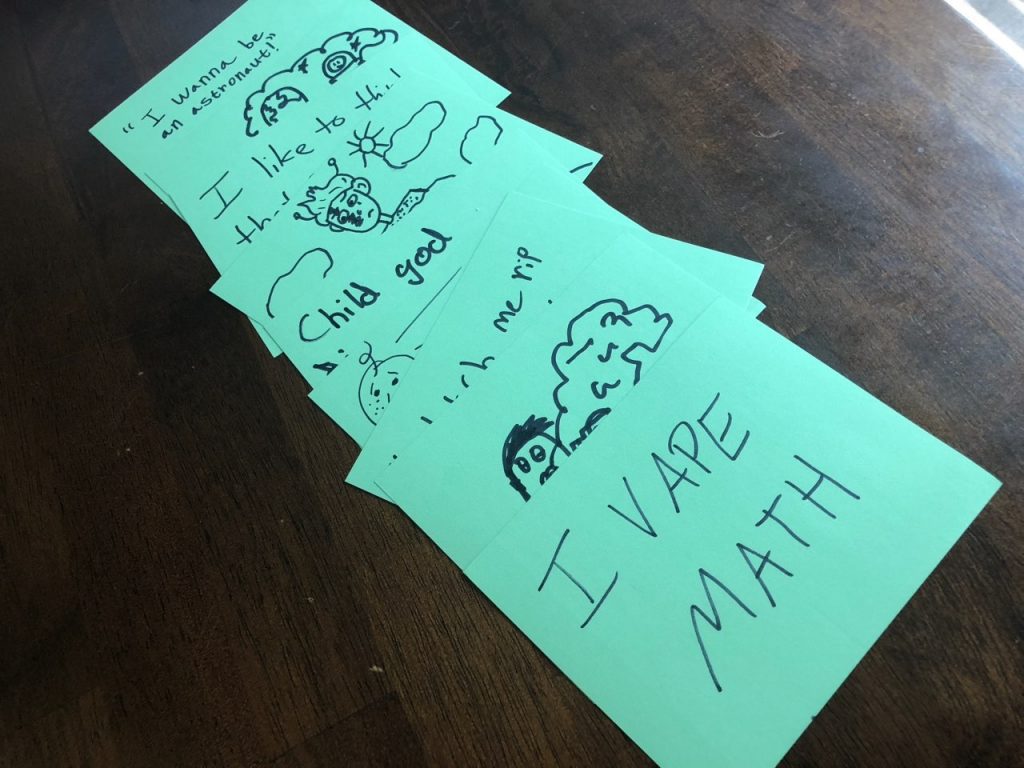
Once this phase is complete, the reveal begins. One at a time players show off their own weird stack of papers, revealing each new sentence and image as drawings are misinterpreted, characters appear and disappear, and the last pages inevitably turn into some absurdist scene resembling what Banksy would draw if he was eight years old. Men with hats become Santa or Abe Lincoln, anyone with a beard usually becomes Jesus, and quite often sleeping people are are mistaken for dead people, derailing the original idea almost immediately. Also if your group is anything like mine, no one can draw animals to save their life so they will shift species rapidly. The resulting fever dream of a comic takes the hilarious errors of Telephone and the often desperate drawings of Pictionary and turns them into an inside joke factory for your play group. It also scales to any number of players, and the use of drawings and writing means most people can show off their strength with one or the other. As we used to say when teaching the game, no one loses in Pictionary Telephone, but some people might win.
Hex
Supplies: A paper or tile hexagonal board, beads in two colors (coins can work too)
Similar to: Blokus, Hive, Quoridor
Unlike other entries on this list whose histories are ambiguous and passed via oral tradition, Hex is a relatively recent and rigidly defined abstract game. It was invented not once, but twice: first by mathematician Piet Hein in Denmark, then a few years later John Nash of “A Beautiful Mind” fame also came up with it at Princeton. Given its geometric nature it made great fodder for academics looking for new papers to publish.
The goal is to create a complete path from one side of the board across to the opposite side by taking turns placing one stone at a time on the hexagonal board. This basic set of rules creates a tense two player battle for board control: players need to split their time between building offensively and blocking defensively.
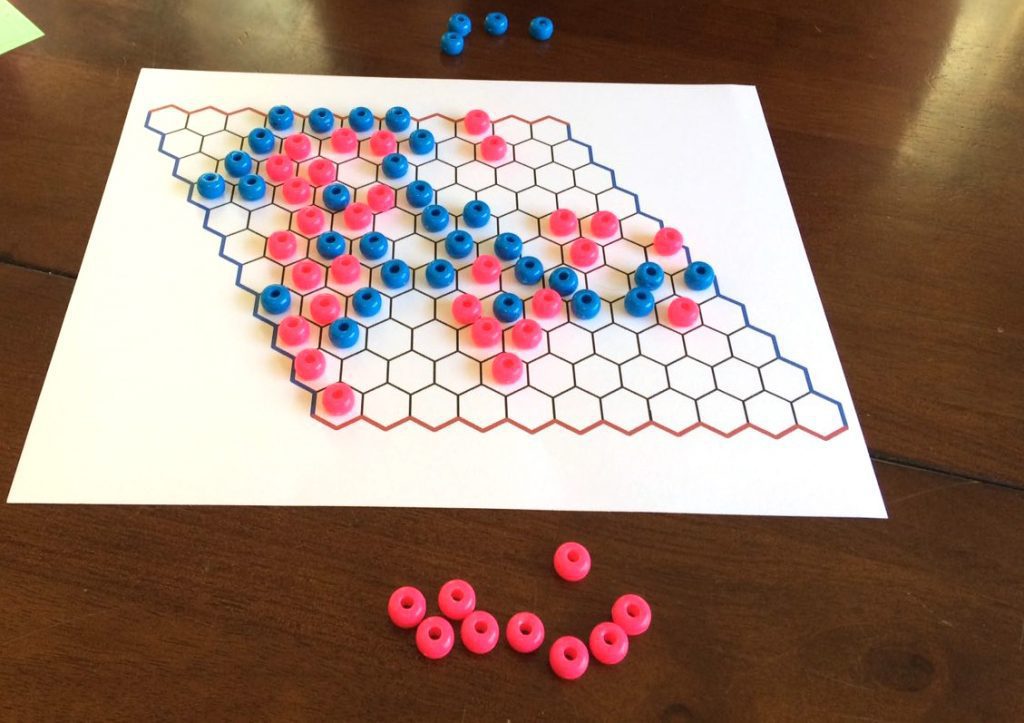
And while mathematically a tie game is impossible, it’s also been proven that the first player has an advantage, so make sure to use the pie rule where one player makes the first move, and the second decides to either play as normal or take over the first player role. So if you have a printer (or a steady drawing hand) and two sets of coins, you have access to an easy to learn, tough to master strategy game. This likely inspired the genre of two player grid games from Quoridor to Tak where the choices of when and where to spend your limited turns compound as the game progresses, and unless you add in some handicapping, the most skilled player will typically come out on top.
Jotto
Supplies: Pens and paper
Similar to: Code 777, Mastermind, Zendo
In 1987 a Canadian TV studio filmed a brand new game show hosted by Ronald Reagan’s adopted son. It was called Lingo, where contestants in teams of two take turns guessing five letter words, receiving hints if they had a correct letter and if it was in the correct position. 15 years later it was revived as a staple of the game show network schedule with Chuck Wooley hosting 5 seasons of the word game. This game concept, like the classic retail game Mastermind but with letters, predated the show as the game of Jotto.
Now here I have to admit I’m cheating a bit. After doing some research, it turns out Jotto was invented by Morton M. Rosenfeld, who produced it in 1954, later selling the game to a publisher. But since it’s no longer being sold in that form, pen and paper will do fine.
To play Jotto, you and an opponent secretly select a five letter word, writing it somewhere secure, and then begin taking turns guessing at the other’s secret word. When a guess is made, the opponent responds with the number of letters it has in common with their secret word. For example if you guessed “APPLE” and my secret word was “PEARS” I would reply “3”. The game ends once someone gets a score of 5, meaning you’ve guessed the secret word (or at least an anagram of it).
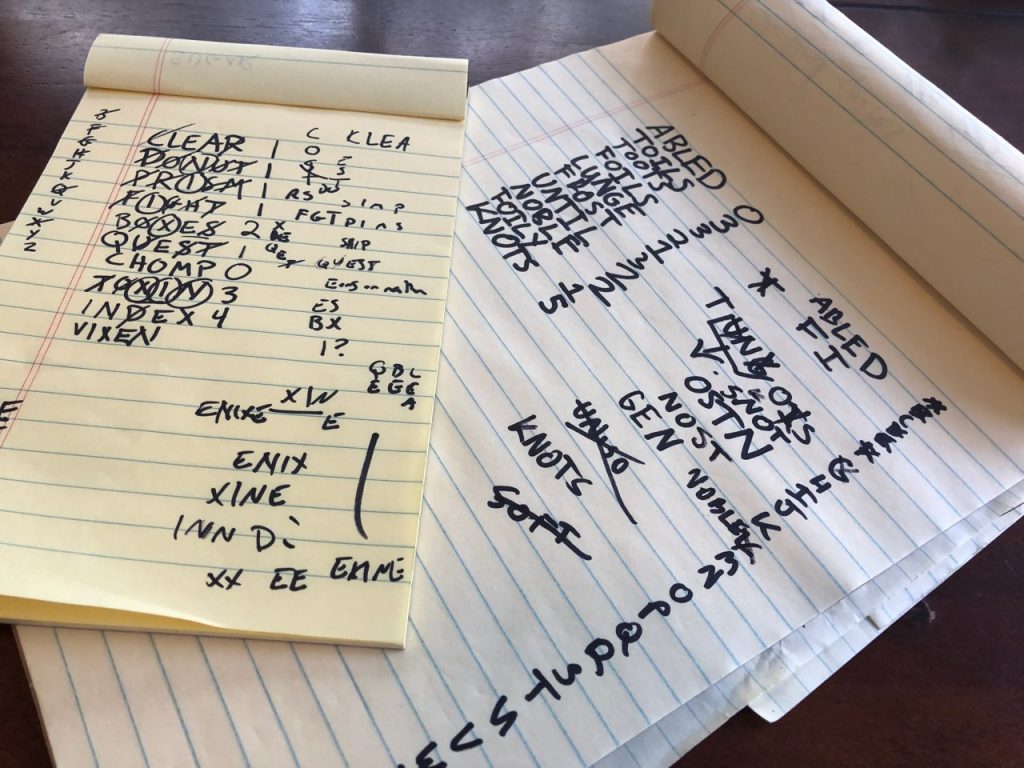
This game is great for passing time where you have only enough room for pen and paper. It’s also a great next step from Hangman for older children. I used to play it often over instant messenger and forums online in my teenage year, which explains a lot about me. Friends of mine would start upping the ante with multiplayer variants and increasing the letter count to 6 or 7. I also have bitter memories of losing to a friend who would use words like “crwth” as his secret word, which is an archaic Welsh lyre.
Hopefully you’ve found a new classic in your favorite genre from this article, without having to make new shelf space for it. If I missed your favorite game you can play at home with supplies you already have, leave a comment or reach out on social media, maybe I’ll find a new classic too!


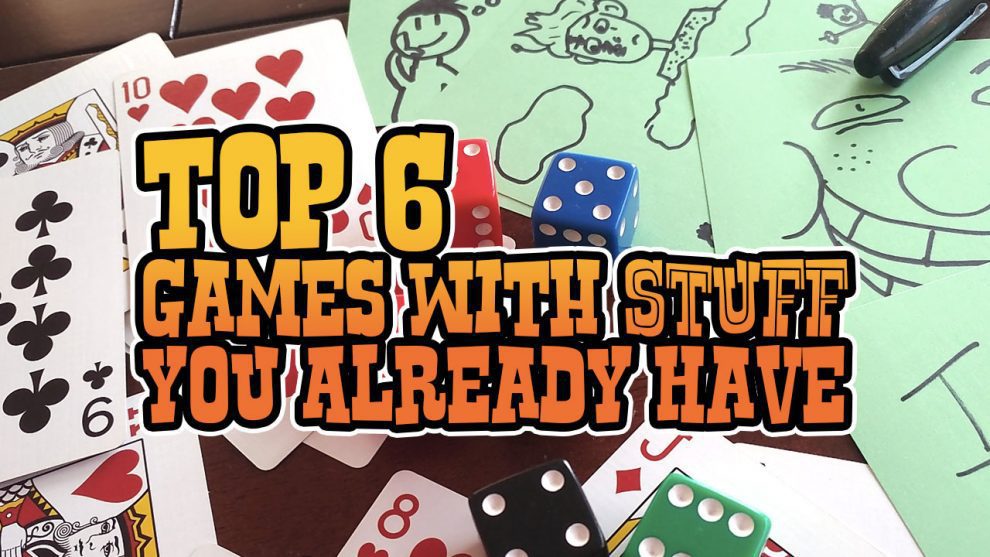
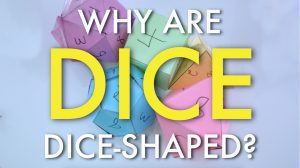





Add Comment